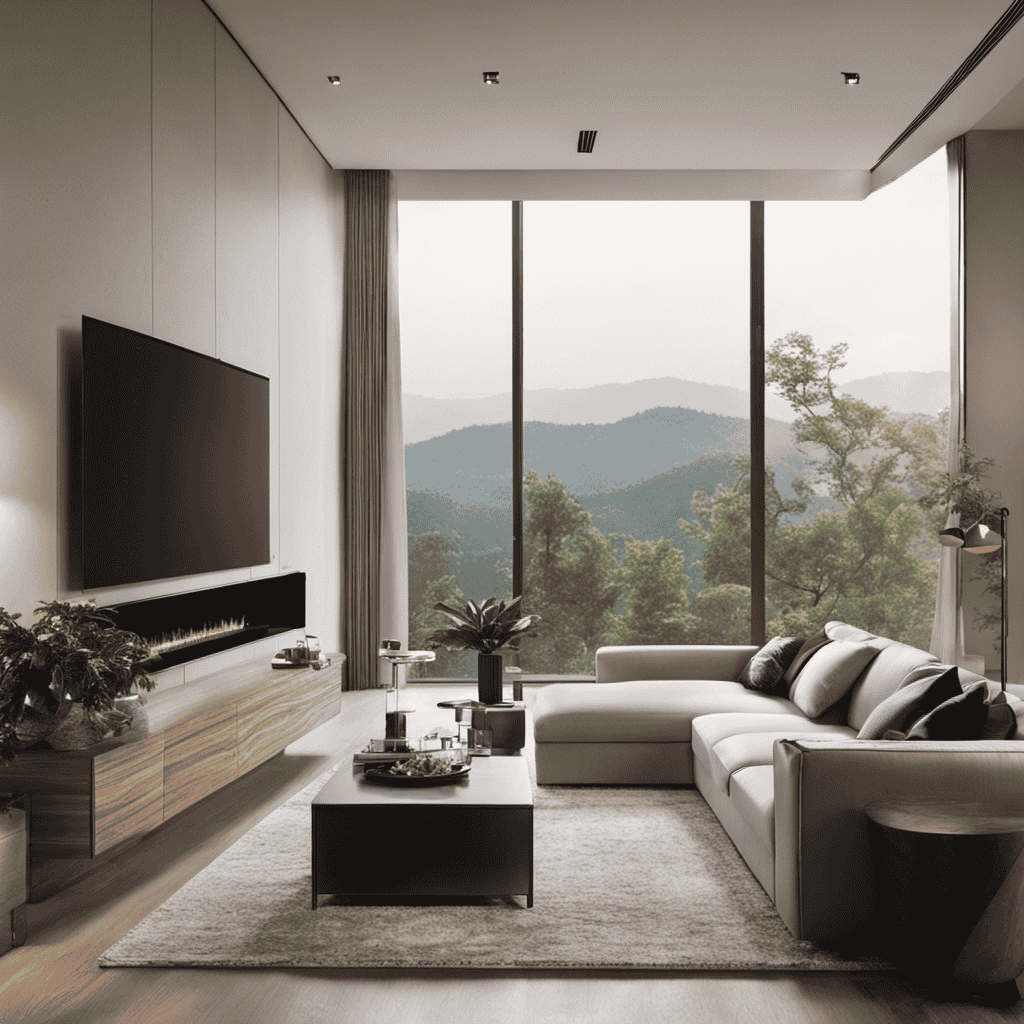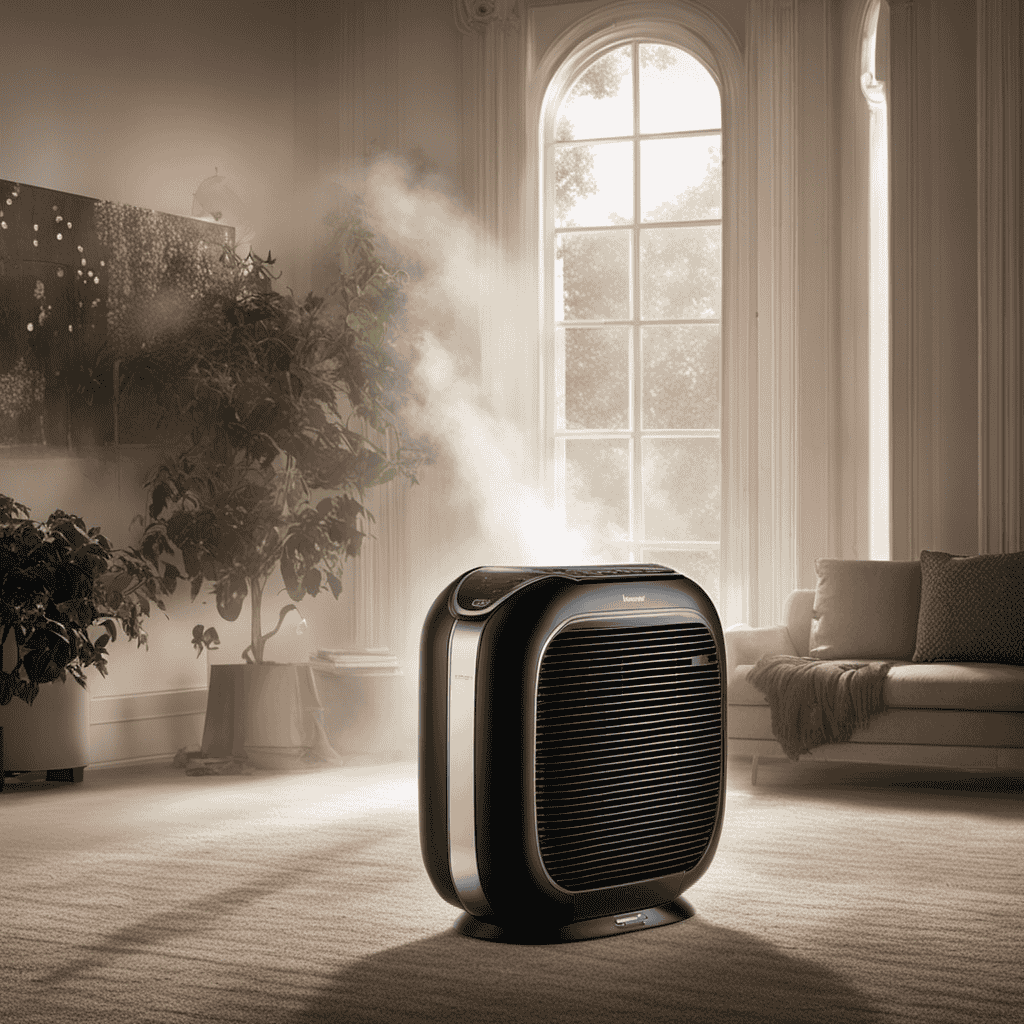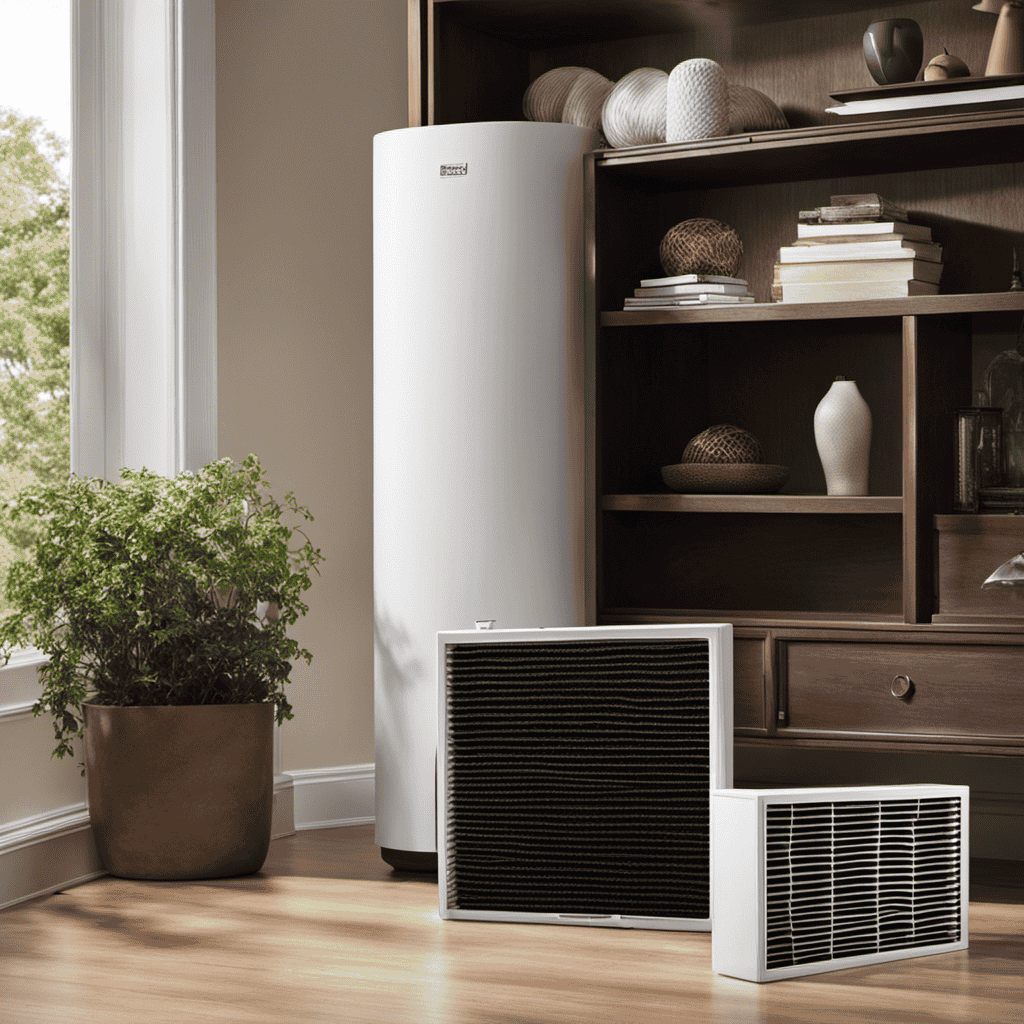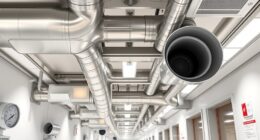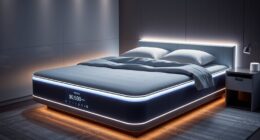Being someone who prioritizes health, I have always searched for methods to enhance the air quality in my household. Given the current pandemic situation, the importance of having clean and purified air has become increasingly vital.
That’s why I decided to delve into the topic of where to place air purifiers to combat COVID-19. In this article, I will guide you through the best locations within your home to maximize the effectiveness of your air purifier, ensuring a safe and healthy environment for you and your loved ones.
Key Takeaways
- Optimal placement of air purifiers enhances their performance and effectiveness in filtering air.
- Central areas of the home, such as the living room and dining room, should be prioritized for air purifier placement to ensure clean air in frequently used spaces.
- Bedrooms and sleeping areas can benefit from air purifiers to create healthier environments, but regular maintenance and filter replacement are important for optimal performance.
- Living rooms and common spaces should have good airflow and ventilation, with regular cleaning of air vents and strategic furniture arrangement to prevent obstructions.
Importance of Proper Placement
To ensure maximum effectiveness, make sure you place your air purifier in the most optimal location within your home. Optimal positioning plays a crucial role in enhancing the performance of your air purifier and improving the air quality in your living space.
When it comes to choosing the right spot for your air purifier, consider the air circulation in your home. It is important to place the purifier in an area where it can effectively circulate and filter the air. Ideally, you should position it in a central location, such as the living room or bedroom, where it can have the greatest impact on the air quality throughout your home.
Avoid placing the air purifier in corners or behind furniture, as this can obstruct airflow and reduce its efficiency. Instead, opt for an open area where the purifier can draw in air from all directions and distribute clean air evenly.
Additionally, keep in mind any potential sources of pollution in your home. If you have a specific area with high levels of pollutants, such as a kitchen or a pet area, consider placing the air purifier nearby to target and remove those contaminants effectively.
Central Areas of the Home
In the central areas of your home, it’s important to consider where you can position the air purifier to maximize its effectiveness. The central areas of a home, such as the living room or dining room, are usually the places where people spend most of their time. Therefore, it is crucial to have clean and filtered air in these areas to ensure a healthy indoor environment.
When deciding where to place your air purifier in the central areas of your home, there are a few factors to consider. First and foremost, you need to ensure that the air purifier is placed in a location where it can effectively filter the air. This means positioning it in an area with good airflow and away from any obstructions that may hinder its performance.
To further illustrate the importance of filtration and cost considerations, I have created a table below:
| Importance of Filtration | Cost Considerations |
|---|---|
| Removes airborne particles such as dust, pollen, and pet dander | Initial cost of the air purifier |
| Reduces the presence of allergens, improving indoor air quality | Energy consumption and filter replacement costs |
| Helps to eliminate odors and smoke particles | Long-term cost savings by improving overall health |
Bedrooms and Sleeping Areas
When it comes to bedrooms and sleeping areas, it’s important to prioritize clean air for a restful night’s sleep. One way to achieve this is by using an air purifier. Air purifiers can help remove common pollutants like dust, pet dander, and allergens from the air, creating a healthier sleeping environment.
However, it’s crucial to ensure that your air purifier is properly maintained for optimal performance.
To keep your air purifier running efficiently, regular maintenance is key. This includes cleaning or replacing the filters as recommended by the manufacturer. There are different types of filters available, and it’s essential to choose the ones that best suit your needs. HEPA (High-Efficiency Particulate Air) filters are highly recommended as they can capture particles as small as 0.3 microns, effectively removing airborne contaminants. For those with allergies or asthma, a HEPA filter combined with an activated carbon filter can be even more beneficial as it helps eliminate odors and chemical pollutants.
Remember to check the filter indicator on your air purifier regularly to determine when it needs cleaning or replacement. Additionally, vacuuming the exterior of the device and keeping the surrounding area clean can help prevent dust buildup and maintain optimal performance.
Living Rooms and Common Spaces
The living room is a space where family and friends gather to relax and spend quality time together. It’s important to ensure that the living room has optimal airflow to create a comfortable and healthy environment. Here are some maintenance tips to achieve this:
| Maintenance Tips | Description |
|---|---|
| Clean air vents regularly | Dust and debris can accumulate in air vents, hindering airflow. Regularly cleaning them improves airflow. |
| Rearrange furniture strategically | Ensure that furniture is not blocking vents or obstructing air circulation. This allows for better airflow. |
| Use ceiling or standing fans | Fans help circulate air in the room, promoting better airflow. They can be used in conjunction with an air purifier. |
| Open windows and doors | Opening windows and doors allows fresh air to enter the living room, improving airflow and ventilation. |
| Regularly clean and dust surfaces | Dust and allergens can settle on surfaces, hindering airflow. Regular cleaning helps maintain optimal airflow. |
Home Offices and Study Areas
Having a dedicated home office or study area is essential for productivity and focus. It provides a designated space where one can concentrate on work or studies without distractions. However, it is not enough to simply have a separate room for these activities. The importance of ventilation and the benefits of air purification cannot be overlooked.
Good ventilation is crucial in a home office or study area as it helps remove stale air and circulate fresh air. This can improve cognitive function and overall well-being.
Air purification systems are beneficial in removing harmful pollutants and allergens from the air, ensuring a cleaner and healthier environment for work or study.
Proper ventilation and air purification can reduce the risk of respiratory issues and allergies.
Studies have shown that improved indoor air quality can enhance concentration and productivity.
To optimize the home office or study area, it is recommended to have windows that can be opened for fresh air circulation. Additionally, investing in an air purifier with HEPA filters can effectively remove airborne pollutants, providing a cleaner and healthier workspace.
Kitchens and Dining Areas
To optimize your kitchen and dining area, it’s important to prioritize cleanliness and organization. Keeping a clean and well-organized kitchen not only enhances the aesthetic appeal but also plays a crucial role in maintaining good air quality and minimizing the risk of contamination.
One effective way to improve air quality in the kitchen is by ensuring proper ventilation. Kitchen ventilation systems are designed to remove odors, smoke, and other airborne contaminants from the cooking area. This helps to prevent the accumulation of pollutants and improves indoor air quality. When planning the layout of your kitchen, it’s important to consider the placement of your ventilation system to ensure optimal performance. A well-placed range hood or exhaust fan can effectively remove any pollutants generated during cooking, preventing them from spreading throughout the house.
In addition to proper kitchen ventilation, there are other measures you can take to improve air quality in your kitchen and dining area. Here are some tips:
- Keep surfaces clean and free from food debris.
- Use natural cleaning products to minimize the use of harsh chemicals.
- Avoid smoking or burning candles in the kitchen.
- Opt for non-toxic cookware and utensils.
Entryways and Foyer
When you walk into your home, make sure to create an inviting and organized entryway that reflects your personal style. The design of your entryway sets the tone for the rest of your home and provides the first impression to your guests.
Here are some key elements to consider when designing your entryway:
-
Wall Hooks: Install wall hooks to keep coats, hats, and bags off the floor and create a clutter-free space.
-
Shoe Storage: Incorporate a shoe rack or storage bench to keep shoes neatly organized and prevent them from cluttering the entryway.
-
Console Table: A console table can serve as a stylish focal point while providing a surface for keys, mail, and other small items.
-
Mirror: Hang a mirror in your entryway to add depth and light to the space, as well as providing a convenient spot for a last-minute appearance check.
By paying attention to these details, you can ensure that your entryway is not only visually pleasing but also functional and organized. Creating a welcoming and well-designed entryway will make you and your guests feel instantly at home.
Now, let’s move on to the next section about children’s playrooms and nurseries.
Children’s Playrooms and Nurseries
When it comes to ensuring optimal air quality in children’s playrooms and nurseries, there are several key factors to consider.
Firstly, the placement of the air purifier should prioritize safety, keeping it out of reach of young children to prevent accidents or tampering.
Secondly, the size of the purifier should be appropriate for the room, considering factors such as square footage and the number of occupants, to effectively filter the air.
Lastly, the noise level of the purifier should be taken into account, as excessive noise can disrupt sleep or playtime for children.
Optimal Placement for Safety
For the safest placement of your air purifier during the COVID-19 pandemic, make sure it is placed in a central area of the room. This allows for optimal circulation and filtration of the air throughout the entire space.
Here are a few additional tips to keep your air purifier functioning effectively:
- Regularly clean the exterior of the purifier with a damp cloth to remove dust and dirt buildup.
- Check the manufacturer’s instructions for recommended maintenance intervals and follow them accordingly.
- Keep an eye on the filter replacement schedule and replace it as recommended. A clogged or dirty filter can reduce the purifier’s efficiency.
- Consider investing in a purifier with a HEPA filter, as it is highly effective in capturing particles as small as 0.3 microns, including viruses and bacteria.
Purifier Size Considerations
To ensure optimal performance, choose an air purifier size that suits the dimensions of your room. A purifier that is too small will not effectively clean the air, while one that is too large may consume more energy than necessary. When selecting the right size, consider the square footage of your room and the recommended air changes per hour (ACH) for your specific needs. Here is a table to help guide your decision:
| Room Size (Square Footage) | Recommended ACH |
|---|---|
| Up to 150 | 4-6 |
| 150-300 | 3-5 |
| 300-450 | 2-4 |
| 450-600 | 1-3 |
Proper maintenance of your air purifier is also essential for optimal performance and energy consumption. Regularly clean or replace filters according to the manufacturer’s instructions, and keep the purifier in a well-ventilated area to prevent overheating. By selecting the right size and maintaining your air purifier properly, you can ensure cleaner air and lower energy usage.
Noise Level Impact
When considering where to place an air purifier, another important factor to consider is the impact of noise levels. Air purifiers vary in the amount of noise they produce, with some models being quieter than others. It’s important to find a balance between a quiet environment and clean air.
Here are some key considerations regarding the impact of noise levels when placing an air purifier:
-
Sleep Quality: A noisy air purifier can disrupt sleep, leading to poor sleep quality and potential health issues.
-
Productivity: Excessive noise can be distracting and hinder productivity, especially in work or study environments.
-
Mental Health: A quiet environment promotes mental well-being and reduces stress levels.
-
Concentration: Noise distractions can affect concentration levels, making it harder to focus on tasks.
Home Gym and Workout Spaces
Make sure you position the air purifier in your home gym or workout space to ensure clean and fresh air while you exercise. Air purifiers can greatly benefit these areas by improving air quality and creating a healthier environment for your workouts.
One of the main benefits of having an air purifier in your home gym is the reduction of airborne pollutants such as dust, pet dander, and allergens. These particles can be harmful to your respiratory system and may affect your performance during exercise.
By regularly maintaining your air purifier, you can ensure its optimal performance. This includes changing filters as recommended by the manufacturer and cleaning the unit to remove any dust buildup. Regular maintenance will help to prolong the lifespan of your air purifier and ensure it continues to effectively clean the air in your home gym or workout space.
Additionally, air purifiers can also help to eliminate unpleasant odors, such as sweat or lingering smells from exercise equipment. This can create a more enjoyable and inviting atmosphere in your workout area.
Additional Considerations for Small Spaces
You should also consider the layout and organization of your small space to maximize functionality and create an efficient workout area. When working with limited space, it’s important to make the most of every inch.
Here are some considerations to keep in mind:
-
Utilize vertical space: Install wall-mounted shelves or racks to store equipment such as dumbbells, resistance bands, and yoga mats. This will free up floor space and provide easy access to your workout essentials.
-
Invest in multi-purpose equipment: Look for exercise equipment that can serve multiple functions. For example, a weight bench that can also be used for step-ups or a stability ball that can double as a chair for stretching.
-
Optimize natural light: If possible, position your workout area near a window to maximize natural light. Natural light not only improves mood and energy levels but also makes the space feel larger and more inviting.
-
Consider ventilation options: Proper ventilation is crucial in a small room to prevent it from feeling stuffy and to ensure good airflow during workouts. Install a fan or consider investing in a portable air purifier to keep the air fresh and clean.
Frequently Asked Questions
Can an Air Purifier Be Placed in a Bathroom or Laundry Room?
Yes, an air purifier can be placed in a bathroom or laundry room. It is important to consider the size of the room and the specific needs of the space.
Air purifiers can remove particles, allergens, and odors, improving the air quality in these areas. Regular maintenance, such as changing filters, is essential to ensure the effectiveness of the air purifier.
Having an air purifier in these rooms can provide numerous benefits, including reducing pollutants and creating a healthier environment.
Is It Necessary to Have an Air Purifier in Every Room of the House?
It is not necessary to have an air purifier in every room of the house, but there are benefits to using air purifiers during the Covid-19 pandemic.
Air purifiers can improve indoor air quality by filtering out particles and pollutants, including viruses. They can help reduce the risk of airborne transmission and provide cleaner air for you and your family.
Placing the air purifier in commonly used areas like the living room or bedroom can be effective in improving overall air quality.
Can Air Purifiers Eliminate the Smell of Cigarette Smoke?
Air purifiers can be effective in eliminating the smell of cigarette smoke. They work by filtering the air and removing particles, including smoke odor molecules.
However, it’s important to note that the effectiveness may vary depending on the type and quality of the air purifier. Regular air purifier maintenance, such as cleaning or replacing filters, is crucial to ensure optimal performance.
Additionally, using an air purifier has other benefits, like reducing allergens, improving indoor air quality, and providing relief for those with respiratory issues.
Can an Air Purifier Help Reduce Allergens From Pet Dander?
An air purifier can be effective in reducing allergens from pet dander. It helps to capture and filter out microscopic particles like pet hair, dander, and pollen from the air.
To maximize its effectiveness, regular maintenance is crucial. This includes cleaning or replacing filters, emptying the collection tray, and keeping the purifier in a well-ventilated area.
Placing the air purifier in a central location where it can circulate air throughout the room is recommended.
Is It Safe to Place an Air Purifier Near a Window or Door?
It is important to consider the effectiveness and maintenance of an air purifier when deciding where to place it near a window or door.
Placing the purifier near these openings may help to improve air circulation and filtration.
However, it is necessary to ensure that the purifier is not obstructed by any objects that could impede its performance.
Regular maintenance, such as cleaning or replacing filters, is also crucial for optimal air purifier function.
Conclusion
In conclusion, placing an air purifier in the right location is crucial for maximizing its effectiveness in reducing the spread of COVID-19.
Whether it’s in central areas like the living room or bedrooms, or specific spaces like home offices or children’s playrooms, strategic placement can help ensure clean, purified air throughout the home.
Just like how a lighthouse guides ships through rough waters, a well-placed air purifier can act as a beacon, guiding us through the challenges of this pandemic by creating a safe and healthy environment.

